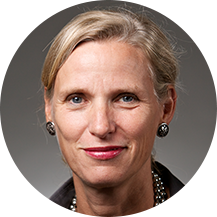Is Digital the Future of Health Care?

Want to lose weight? Sleep better? Get more exercise? There’s an app for that. In fact, there is an emerging industry of digital health solutions—including apps, tools, and devices—that aim to improve health and wellness for millions.
EDC’s Rebecca Stoeckle is an expert in designing technology-based behavioral health interventions. She believes that technological advances are reshaping the access to, and delivery of, health care—right down to the doctor-patient relationship. Stoeckle is currently serving on the executive board of Stanford University’s Medicine X, an initiative that is exploring the intersection of technology, medicine, and patient health.
Q: What are digital health solutions?
Stoeckle: I think of a digital health solution as any technological tool that seeks to improve patient health or that empowers patients to take action on their own health. We are seeing an upsurge in patients’ interest in this kind of agency—and a growing recognition by the health care system that when patients do so, their outcomes improve, and sometimes costs are lowered. So now there is this explosion in digital tools and apps that allow patients to better understand and regulate their behavior. FitBit is one example. There are also online tools to help people cope with PTSD or to manage how much they drink.
Q: How is the use of technology impacting health care?
Stoeckle: Technology innovations are expanding a physician’s ability to make the most accurate, timely diagnosis for a patient. Perhaps the biggest advance is that artificial intelligence and big data are reducing the risk that any given physician will miss a diagnosis or a best treatment option for any given patient.
Take, for example, a physician who sees a patient with a rare health condition. In the past, that physician would only be able to draw upon his or her own knowledge—as well as whatever he or she knew about the patient’s health history—to make a diagnosis. But now, the patient’s electronic health record can also display possible diagnoses and treatments based on health data from thousands of other patients with similar symptoms.
Q: How is technology changing doctor-patient relationships?
Stoeckle: Patient-based digital health tools empower the patient to take charge of his or her health in between visits to the doctor. Patients spend 99.9 percent of their lives somewhere other than the doctor’s office. Digital tools can give them access to resources they can use to support healthy behaviors between clinical encounters. Patients have so much access to information now—through personal medical records, online patient communities, and health apps, for example—that they can bring a wealth of knowledge about their own health to the doctor’s office. This patient expertise is being valued in a way that it was not before.
Doctors also see a benefit to this equalizing of the doctor-patient relationship. They can now expect their patients to take a more active role in monitoring and tracking their health. This means that in those precious 15 minutes when a doctor and patient are together, they can have a more meaningful conversation about the patient’s health and wellness.
Q: What does it mean to be an empowered patient?
Stoeckle: An empowered patient takes an active role in his or her health care and is proactive in accessing information and tools that will help him or her remain healthy and functioning at the highest level.
This is where digital health solutions can truly make a difference and be used to support and strengthen an ongoing doctor-patient relationship. For example, people with an anxiety disorder can use a phone app to track their mood or access coping techniques wherever they happen to be. They can also log this information and then discuss it with their doctor at the next appointment.
Q: What have you learned from developing digital health tools?
Stoeckle: One lesson is to recognize that you can develop the spiffiest app with the most gorgeous user interface, but if nobody knows about it, it won’t have an impact. So you have to work with partners and practitioners from the outset to make sure they are going to get that app into the hands—literally, in the case of a mobile app—of the end users.
Another lesson is to involve end users at every stage of the development cycle. Patients have important insights into whether a tool is welcoming, easy to use, or even relevant. The ideal digital health solution will be evidence based and also meet the needs of the end user. And when tools are designed that way, they can have tremendous impact.
